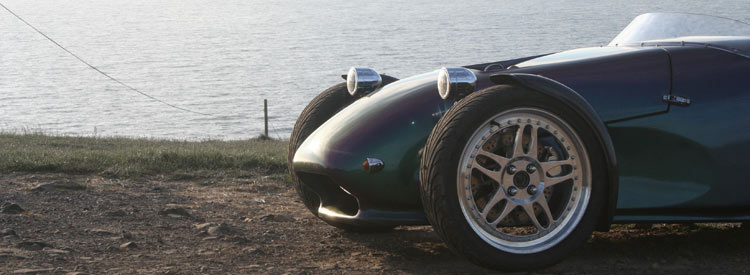


![]()
SKUNK SPORTS SPECIAL
Sweet Smell Of Success
Page3
The rest of the dash is extremely simple, with a large and cavernous glove compartment providing useful storage. There's obviously no conventional gearshift, but the propshaft running to the back wheel enforces a small centre tunnel. A little Mini handbrake sits to one side.
The all-up weight of this second prototype is a staggeringly light 290kgs, which instantly gives notice of the performance capability of the bike installations. Delivering just over 105bhp, even the Yamaha's 900cc engine will give the Skunk some 362bhp/tonne. Fit it with a 145bhp Yamaha GSX100R engine and those figures quickly rise to a mind-boggling 500bhp/tonne! So what are we waiting for, let's get started...
It's always an encouraging sign when you jump into a car and don't have to adjust anything. You might sometimes want to move the seat slightly, but I think a good driving position (ie the relationship between pedals, steering wheel, seat height and length) generally requires minimal fiddling and compromise. 4-point harnesses hold me in tightly to Malone's own lightly-padded seat shells. At the moment the padding is a little Heath Robinson, but the company is looking for some neat coloured foam that it can cut to shape for production versions.
The steering wheel in the car is encouragingly large. I always find small 10" items are only justified in racing cars and, when used in kit cars, are usually another throw-back to compensate for a poor driving position. Down in the footwell the floor-mounted pedals feel fine, with a decent heal support - the latter helps in actually using the pedal and also stops your legs getting tired over a longer journey. Obviously there's no gearstick to contend with and, as soon as you grasp the steering wheel, the paddle shift seems completely natural.
Twist the dash-mounted ignition key and the Yamaha bike engine barks into life before settling into a completely un-car-like idle and exhaust note. Neutral is shown by a green dash warning light and you squeeze the left hand paddle to select first before pulling on the right hand paddle for second, third, fourth and fifth. To go back down you're pulling on the left hand paddle again, right down to first before jiggling the lever slightly to find neutral again.
Jon Malone tells me it isn't strictly necessary to use the clutch for fast up-changing, but not being a biker I err on the side of caution and keep to car convention. Moving off smoothly from a standstill is a bit of a knack, requiring a healthy handful of revs and a delicate but prompt use of the clutch. Bike gearboxes don't like too much feathering of the clutch and if you don't get it quite right it's easy to stall the engine or judder away off the line.
From just about the very first gear change the paddle shift seems the only way forward for bike-powered kits. It's absolutely fantastic. Your hands remain on the steering wheel and you can change up so much faster without fishing around for a gearstick. These are Mk2 versions and they seem fine. Unlike on a Formula 1 car, there remains a conventional rod linkage coming off the back of one of the paddles before diving through a hole in the dash and wending its way to the gearbox via two or three rose-jointed links. There can be no two ways about it, as soon as other manufacturers cotton on to how this is done, I'm convinced we'll see more kits following suit.
But if there's a practical benefit to using this sort of system, there's also another advantage - that of novelty. Owning any kit car is about having fun in something that's a little different and the paddle shift (and bike engine) goes a huge way to achieving something completely different from the norm. It instantly makes the Skunk a bit special and that, when we come down to it, is what makes most of us want to own a kit car in the first place.
With a red line hovering at around the 10,000rpm mark (proceeded by no less than three progressive change-up lights on the SPA rev counter), things get pretty manic very quickly indeed. The first few gears are dispatched in seconds before you then flick between the top two or three to maintain a maximum adrenalin rush. Changing up is most fun, with the rev counter screaming round the gauge so fast you almost struggle to keep up with the gear changes. It's frantic, race-inspired stuff that's unlike anything you'll achieve from a conventional car engine.
Performance is unquestionably impressive although there's not the thump of power you get with a more torquey car unit. In truth it doesn't feel like over 300bhp/tonne but there's no question that the Skunk does indeed 'go like stink'. Malone quotes a 0-60mph time of just over five seconds and that doesn't seem too far off the mark. Obviously, putting the power down effectively through the single 195x50x15 rear tyre is critical, while over-taking manoeuvres require more precise gear-selection than you could get away with in a car.
Whilst no-one has really called into question the performance potential of bike-powered three-wheelers, their handling has certainly been given a bit of a pasting in recent years. Front-wheel lift is what we're talking about here. It's not something you have to worry about with a front-wheel-drive three-wheeler such as a Lomax since as soon as a front wheel could get off the ground power is effectively lost to the drive. On a rear-wheel-drive trike that's not the case and many of you will be aware of the frightening pictures of a JZA turning over at Castle Combe a few years ago.
Quizzing Malone Designs about this distinctly nasty trait, the company's adamant it has the problem cracked. For starters, the engine is right at the front and as low in the chassis as possible. But perhaps most important in Malone's view is getting the balance on the tyres correct. Too much grip up front and things might get exciting. For the Skunk the company has retained front bike tyres and carefully tried to match them with the rear car tyre. The end result is that the car will either understeer or move into a three-wheeled power drift if pushed to its handling limits. According to Jon, they've been completely brutal in testing the current demo car and never seen a front wheel lose contact with the tarmac.